We had an incredible, whirlwind five days co-creating public spaces with Pablo Muñoz, Luisa Torres, Josefina Ovalle Parot, and the amazing community of Santa Coloma de Gramenet. It felt like a rapid-fire game—running around the park, talking to people, collecting stories, analyzing data in GIS and Grasshopper, figuring out who to design for, and then imagining solutions that could actually take shape in the space itself. It was intense, messy, and so much fun.
This is our debut IAAC blog – here’s a look at what we explored and created together –
The Climb of Connection
‘Santa Coloma de Gramenet is a municipality within the metropolitan area of Barcelona, positioned on the left bank of the Besòs River and bordered by Sant Adrià del Besòs, Badalona, and the Serralada Marina mountains. Between 1950 and 1975, waves of rural-urban migration brought many vulnerable populations seeking work to Barcelona and its surroundings. This accelerated, largely unplanned urbanisation created a dense, compact city with limited public spaces and few urban amenities. Even today, overlapping inequalities—insufficient affordable housing, low-quality dwellings, poverty, and challenging topography—persist in neighborhoods around Parc dels Pins.
To understand the park’s role in this urban fabric, we mapped its surroundings using 5 and 15-minute isochrones. The analysis revealed that most households in the area earn between €1,389 and €2,589 monthly, and the population is predominantly of Moroccan, Pakistani, and Chinese origin. Analysis of the age pyramid showed that children aged 0–19 constitute roughly 10.65% of the population, with the 10–14 age cohort most concentrated near the park. This highlighted the park as a critical focus for inclusive spatial and social interventions.

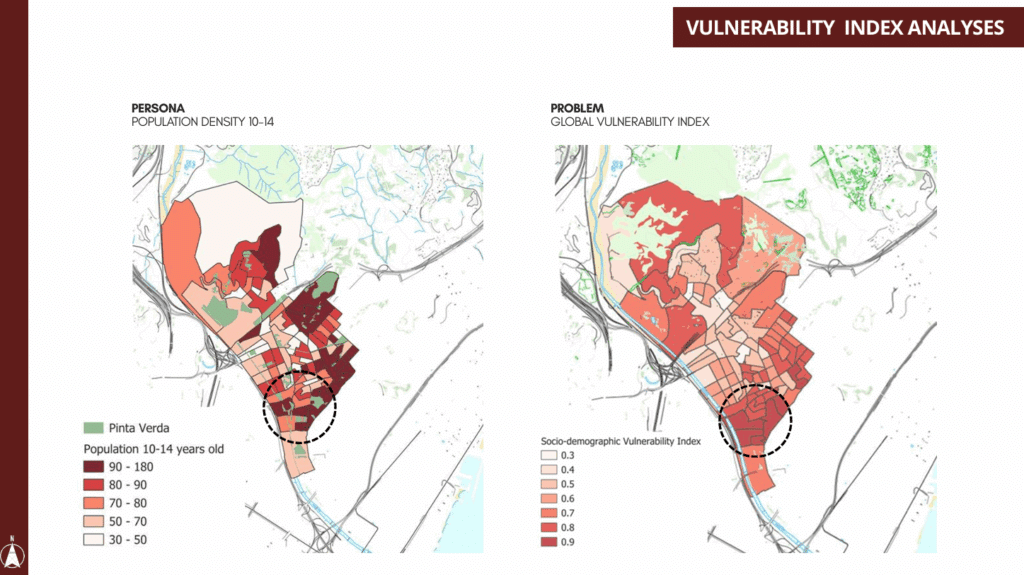

This age group faces complex vulnerabilities. Socially, they encounter peer pressure and exclusion; emotionally, they navigate identity formation and mood swings; physically, curiosity and risk-taking increase their likelihood of accidents; environmentally, urban density and limited green space reduce safe play opportunities; and educationally, school pressures and digital divides can hold them back. Despite these challenges, this is also a stage of high energy, curiosity, and creativity—a perfect opportunity for thoughtful urban interventions. Importantly, the city offers almost no spaces designed for this age group: traditional parks feel too childish, while other public areas are often dominated by adults or feel patronizing.
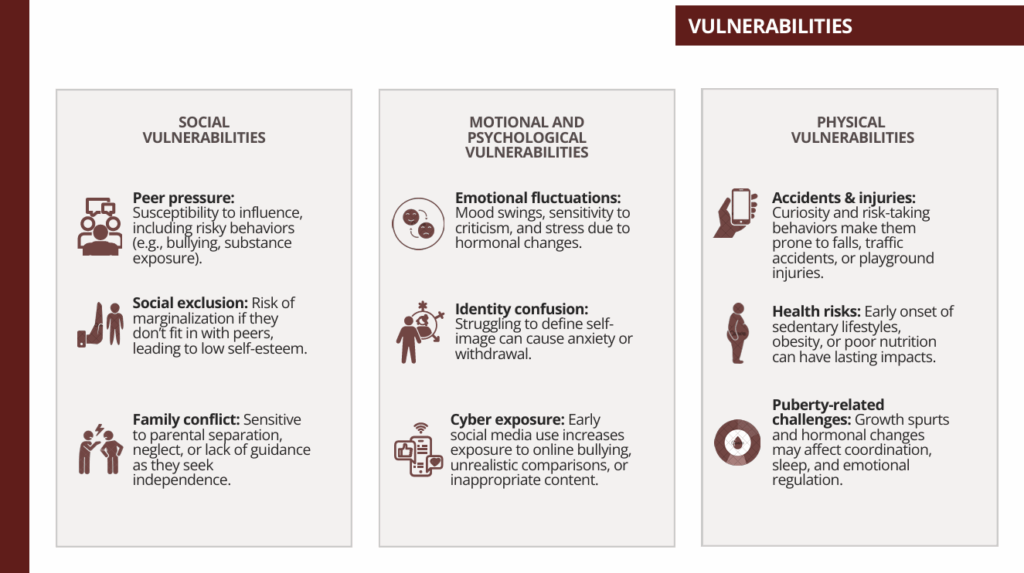
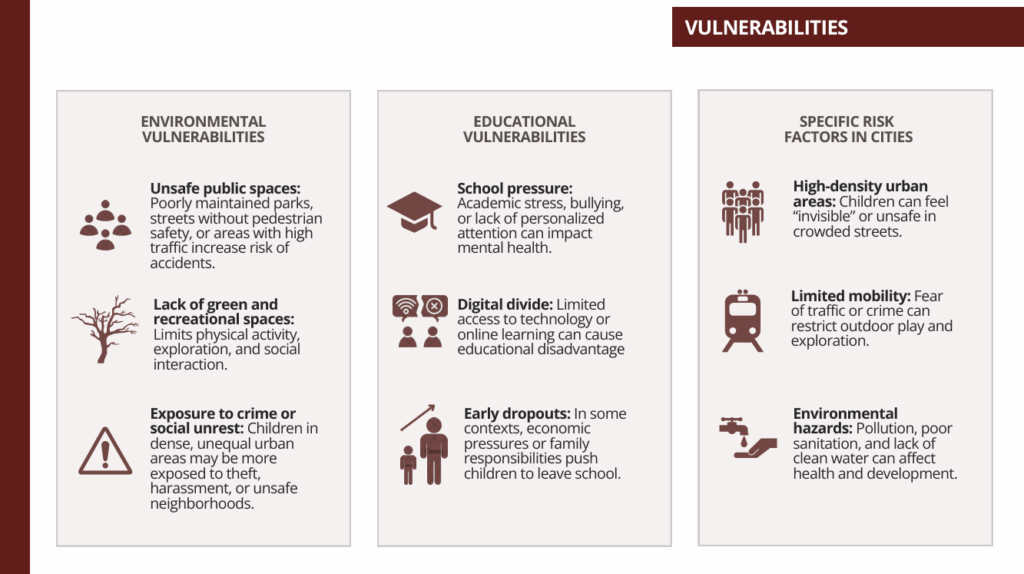

Parks and public spaces can address these vulnerabilities while nurturing exploration, autonomy, and learning. Socially, collaborative zones such as team sports areas, group challenges, and community gardens strengthen connections and confidence. Creativity and cognition are supported through outdoor classrooms, art corners, and maker zones, encouraging curiosity, problem-solving, and self-expression. Physical and adventurous features, including climbing nets, slides, cycling tracks, and nature trails, enhance motor skills, risk assessment, and engagement with nature. Emotional and reflective spaces, such as hammocks, quiet zones, mindfulness corners, and water play areas, promote relaxation, self-awareness, and stress relief. Technology can be integrated safely through interactive kiosks, augmented reality trails, and coding or robotics workshops, fostering digital literacy while encouraging outdoor learning. Safety measures, accessibility, and flexibility remain central, ensuring children can explore, socialize, and experiment without undue risk.
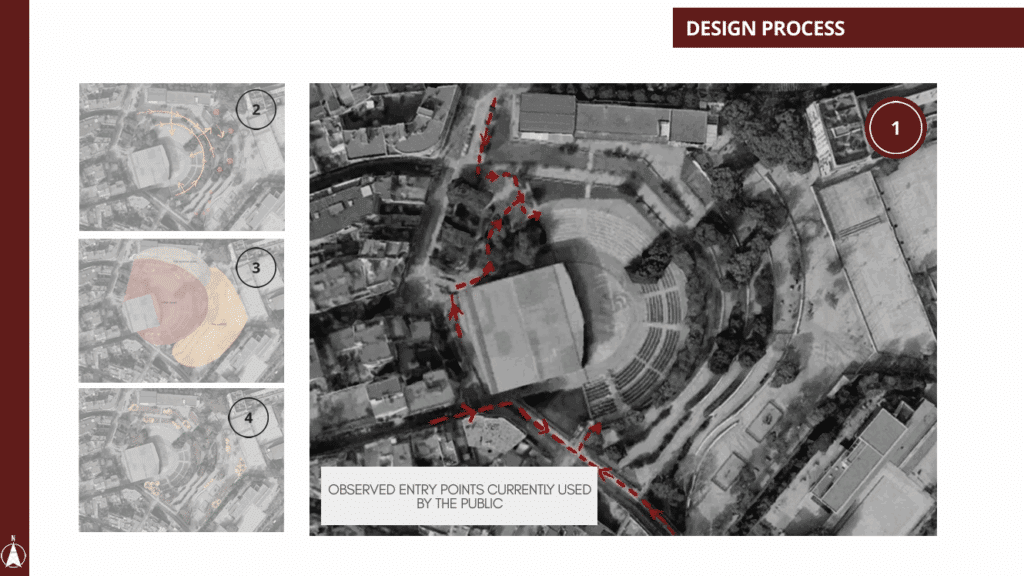
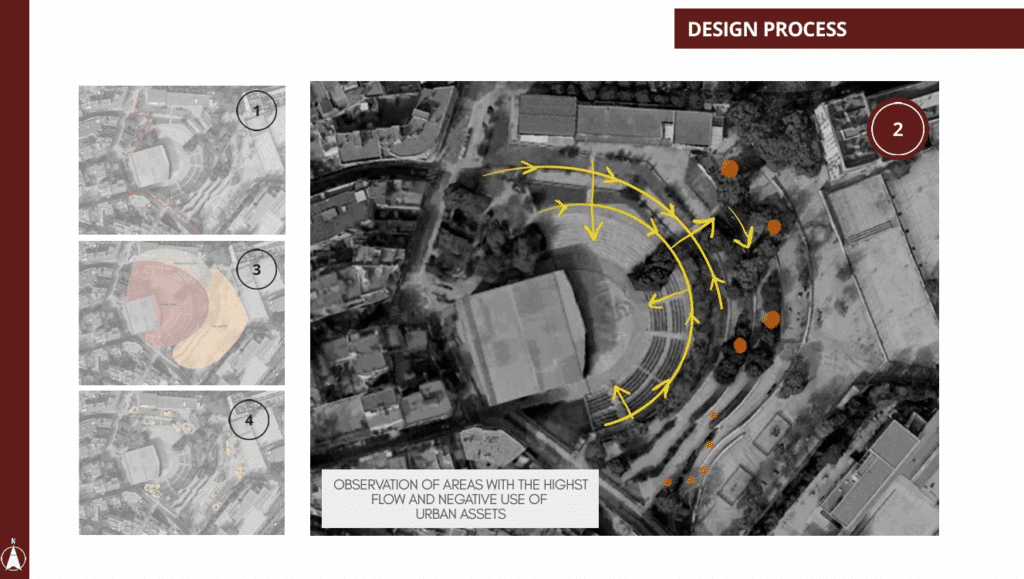
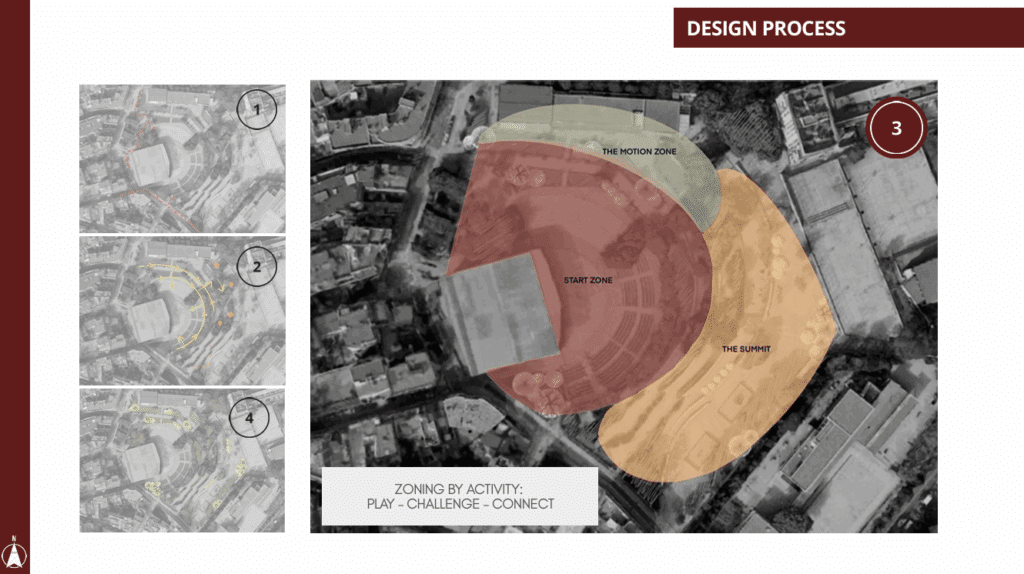
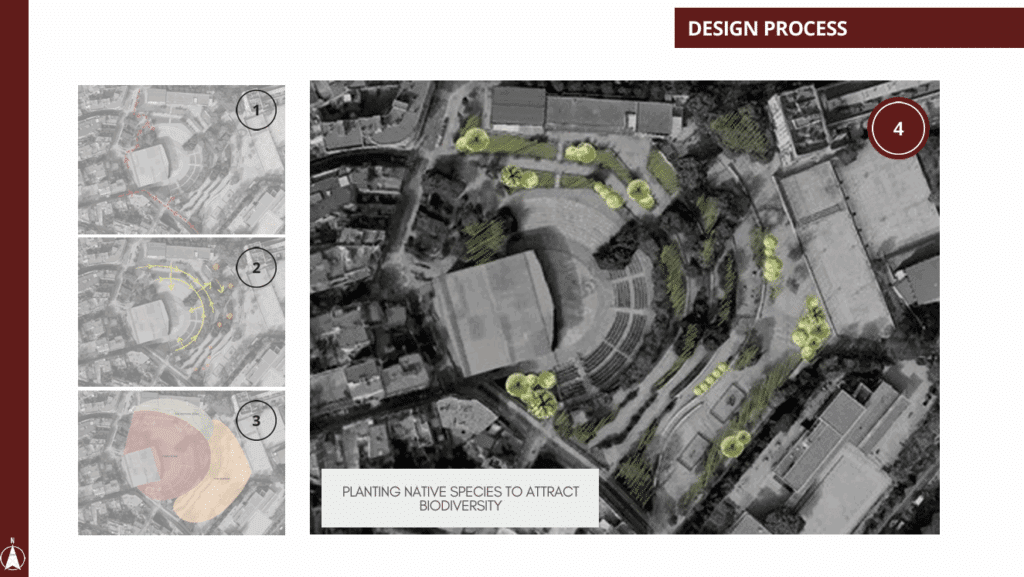
The park site, including the amphitheatre, was studied for its terrain, biodiversity, and accessibility patterns. Observations identified the most frequently used pathways, activity zones, and underutilized “negative” spaces resulting from limited connectivity. Design decisions respected the park’s existing structure and its role in collective memory, adding minimal interventions such as travellators on steeper slopes to enhance accessibility.
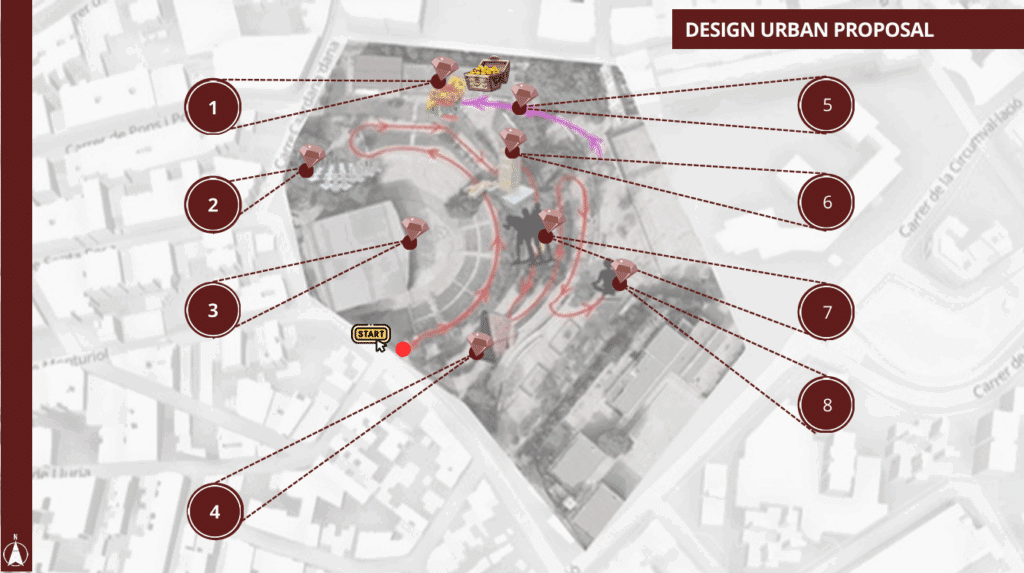
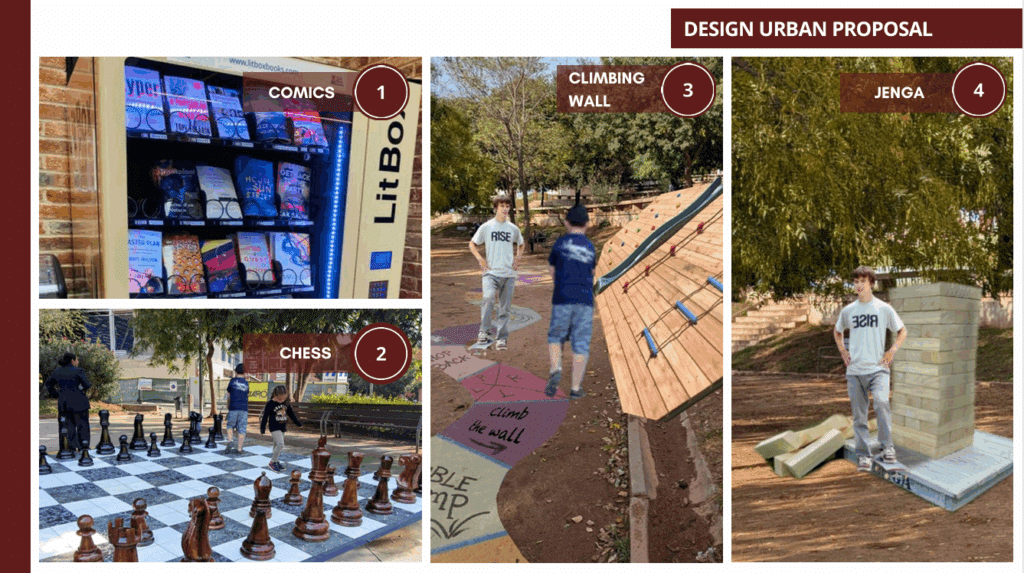

The resulting project, “The Climb of Connection,” transforms the park’s steep topography into an active path encouraging children to disconnect from screens and engage physically, socially, and cognitively. At the base, calm games like human-scale chess or Jenga support focus and cooperative interaction. As the path ascends, the slope itself becomes part of the challenge, incorporating balance games, climbing walls, and team-based tasks that build confidence and encourage interaction. At the top, a viewpoint provides space for rest, reflection, and social exchange, representing both literal and symbolic achievement.
Parc dels Pins is reconceived as a dynamic urban ecosystem where children can play, explore, and exercise autonomy. Rooted in the metaphor of growth through exploration, the park becomes a living classroom and social commons, bridging play, nature, and civic identity. Interventions introduced native vegetation to attract birds and insects, enhancing biodiversity and ecological awareness. Central to the design is a gaming loop that integrates physical and digital play. Children begin the game by scanning a code and accumulate points by participating in playground activities and interacting with the EcoDesk, an augmented reality scavenger hunt. These points can then be exchanged for rewards such as comics, puzzles, or toys provided by the school adjacent to the park, linking play, learning, and tangible incentives.
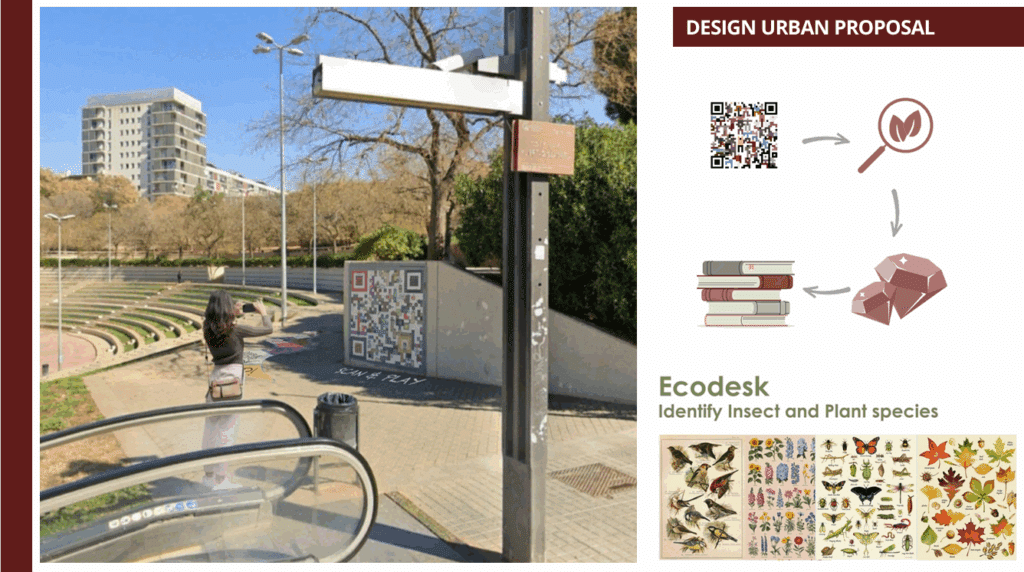
The EcoDesk reimagines environmental learning as a playful, tech-integrated scavenger hunt. Children become digital-naturalists, uncovering and cataloguing local biodiversity. QR codes and AR markers across the park reveal animated stories, ecological facts, and challenges: a pine tree may tell a story about nesting birds, a butterfly may demonstrate pollination, and a fallen leaf might prompt a question about decomposition. Each discovery is stored in a personal EcoDex, encouraging curiosity, ecological awareness, and a sense of achievement.
Complementing the digital-physical loop, the park hosts multiple experiential spaces designed to address social, creative, and emotional needs. The Loop provides a continuous skate and parkour circuit with ramps and green slopes, promoting safe physical challenge and confidence-building. The Sound Grove encourages collaborative musical expression through interactive installations, while the Makers’ Yard offers timber workshops, graffiti walls, and creative stations for hands-on problem-solving and co-design. Tree Pods and Chill Decks create elevated, semi-private spaces for reflection or socialization. Periodic Community Beats Events, including open-mic sessions and green games days, activate the park and give children opportunities to perform, collaborate, and take pride in their space.
Ultimately, “The Climb of Connection” demonstrates that public spaces can do more than provide recreation—they can become platforms for learning, creativity, and social inclusion. By centering design on the needs and aspirations of children, the project fosters a sense of ownership and pride, encouraging the next generation to engage actively with their urban environment. Parc dels Pins becomes a model for how cities can thoughtfully integrate play, nature, and technology to support youth development, strengthen community bonds, and build resilient, vibrant neighborhoods for the future.’
By the end of those five crazy days, we hadn’t just designed a park—we’d run through a mini urban design adventure, testing ideas, listening to kids, and seeing how play, nature, and technology could collide in real time. Parc dels Pins was our canvas, and while it was just an exercise, it showed how rapid-fire collaboration can spark ideas that might one day make real neighborhoods feel more alive, playful, and connected.
Stay tuned—there’s more design chaos and city adventures coming soon!

